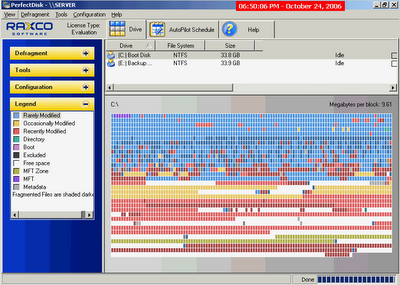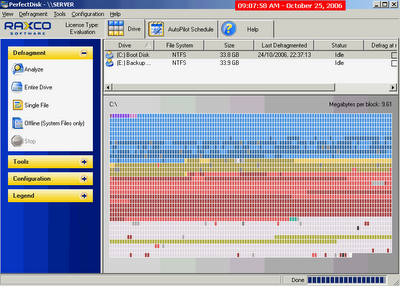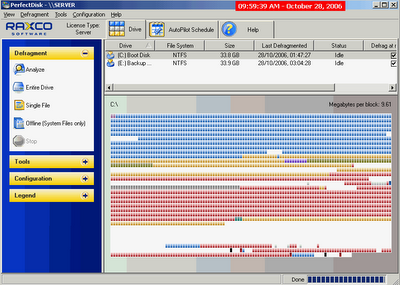
This is the "before" picture. It's a
Windows 2000 Small Business Server drive, running both
SQL Server 2000 and
Exchange 2000. It was also using
Diskeeper 9 Server Standard, scheduled to do a defragment every weekend. The performance has got worse over time, and eventually I realised that
Diskeeper just wasn't up to the job. The "before" picture above was taken
after I had got
Diskeeper to do a
complete boot-time defragment and a
full defrag to the best of its ability. As you can see the drive is in a mess.

This is the drive after the first pass using
PerfectDisk 8. The analysis recommended a boot-time defragmentation, but we couldn't do it straight away because the server is in use. As you can see from the picture there is still a lot of fragmentation, and the metadata is in a real mess, with close to 1000 fragments in total. Thanks for nothing,
Diskeeper!

Finally, after doing two boot-time defragmentation passes, and a complete defragment overnight, and then a quick pass using contig, the drive is in much better condition.

The other thing I like about
PerfectDisk is that it has a "batch file" mode called
PDCmd, so you can run a batch file that cleans up unwanted files using
Hunter-Killer, then stops the
SQL Server service, does a complete defagmentation, and finally starts the
SQL Server services again. All automatically and unattended. Remember this is a live server, with
SQL Server making backup files from time to time, and users saving documents from their workstations. Even so, the drive is in much better shape and
SQL Server is performing well once again.
 This is the "before" picture. It's a Windows 2000 Small Business Server drive, running both SQL Server 2000 and Exchange 2000. It was also using Diskeeper 9 Server Standard, scheduled to do a defragment every weekend. The performance has got worse over time, and eventually I realised that Diskeeper just wasn't up to the job. The "before" picture above was taken after I had got Diskeeper to do a complete boot-time defragment and a full defrag to the best of its ability. As you can see the drive is in a mess.
This is the "before" picture. It's a Windows 2000 Small Business Server drive, running both SQL Server 2000 and Exchange 2000. It was also using Diskeeper 9 Server Standard, scheduled to do a defragment every weekend. The performance has got worse over time, and eventually I realised that Diskeeper just wasn't up to the job. The "before" picture above was taken after I had got Diskeeper to do a complete boot-time defragment and a full defrag to the best of its ability. As you can see the drive is in a mess. This is the drive after the first pass using PerfectDisk 8. The analysis recommended a boot-time defragmentation, but we couldn't do it straight away because the server is in use. As you can see from the picture there is still a lot of fragmentation, and the metadata is in a real mess, with close to 1000 fragments in total. Thanks for nothing, Diskeeper!
This is the drive after the first pass using PerfectDisk 8. The analysis recommended a boot-time defragmentation, but we couldn't do it straight away because the server is in use. As you can see from the picture there is still a lot of fragmentation, and the metadata is in a real mess, with close to 1000 fragments in total. Thanks for nothing, Diskeeper! Finally, after doing two boot-time defragmentation passes, and a complete defragment overnight, and then a quick pass using contig, the drive is in much better condition.
Finally, after doing two boot-time defragmentation passes, and a complete defragment overnight, and then a quick pass using contig, the drive is in much better condition.
1 comment:
Wow! You do have perhaps one of the planet's most thorough defragging strategy.
Thanks for opening my eyes on the goodness of PerfectDisk. I had been a user of Diskeeper, but I truly dislike DK's insisting of 20% free space. I uninstalled DK, got PD, and run with it. All is well, but I'm still worried.
Thanks to the shootout I'm now perfectly content with PD. And your defragging of a live server strategy is also wonderful. Can you tell me more about it? Perhaps a blog entry detailing it?
Thanks again for a nice blog!
Post a Comment